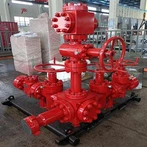Materials and Structures:
Composite frac plugs are engineered using advanced materials and innovative structures to deliver superior performance in downhole operations.
Its structure consists of several components, including composite mandrels, slips, and elastomeric sealing elements. The composite mandrel forms the core of the plug, providing structural support and anchoring points for the other components. The slips, made of hardened materials such as tungsten carbide, are designed to grip the casing or wellbore walls, securing the plug in place. Elastomeric sealing elements, often made of nitrile rubber or specialized elastomers, create a tight seal against the wellbore, preventing fluid flow and ensuring zonal isolation.
The materials and structures are engineered to optimize performance characteristics such as pressure resistance, temperature tolerance, and mechanical integrity, ensuring reliable operation in challenging downhole conditions.
Deployment and Cementing:
The deployment of Composite frac plug is a critical step in hydraulic fracturing operations. These plugs are typically run on wireline or coiled tubing and positioned at the desired depth in the wellbore. Once in place, the plug is set by applying hydraulic pressure or mechanical force, causing the slips to engage with the casing or wellbore walls and securely anchoring the plug.
After the plug is installed, a cementing operation may be performed to further enhance the zonal isolation and strengthen the seal. In this process, cement slurry is pumped into the wellbore and allowed to heal, creating a barrier between the plug and the formation. The cementing operation helps prevent fluid migration and ensures the integrity of the zonal isolation.
Sealing and insulation:
One of the primary functions is to create reliable seals that isolate different formations and prevent fluid flow. This is achieved through a combination of the plug's structural design and the specialized sealing elements incorporated into its construction.
Elastomeric sealing elements, typically made of nitrile rubber or specialized elastomers, are designed to conform to wellbore walls or casing, creating a tight seal that prevents fluid from passing through. These sealing elements are engineered to maintain their sealing integrity under extreme pressure and temperature conditions, ensuring effective zonal isolation throughout the fracturing operation.
In addition, composite materials used in the construction of the plug mandrel and other components provide structural support and prevent deformation or failure, further enhancing the plug's sealing capacity and insulation performance.
Controlled Release:
In some applications, Composite frac plugs are designed to facilitate controlled release under specific conditions, enabling staged fracturing or other operations. This controlled release can be achieved through various mechanisms, such as degradable materials, specialized coatings, or mechanical systems.
For example, some frac plugs incorporate degradable materials such as polymers or fibers that break down under specific downhole conditions, such as high temperatures or exposure to certain fluids. This controlled degradation can cause the plug to release or disintegrate, allowing fracturing fluids to flow and fracture the desired formation.
Alternatively, some plugs may feature specialized coatings or sleeves that dissolve or degrade under predetermined conditions, exposing openings or ports that allow fluid to flow.
Mechanical release systems, such as shear pins or collet mechanisms, can also be integrated into Composite frac plug designs. These systems are designed to release the plug or create flow paths when a specific pressure or force is applied, facilitating staged fracturing or other well interventions.
Vigor will provide you with a reliable solution, Please contact us at info@vigorpetroleum.com.





